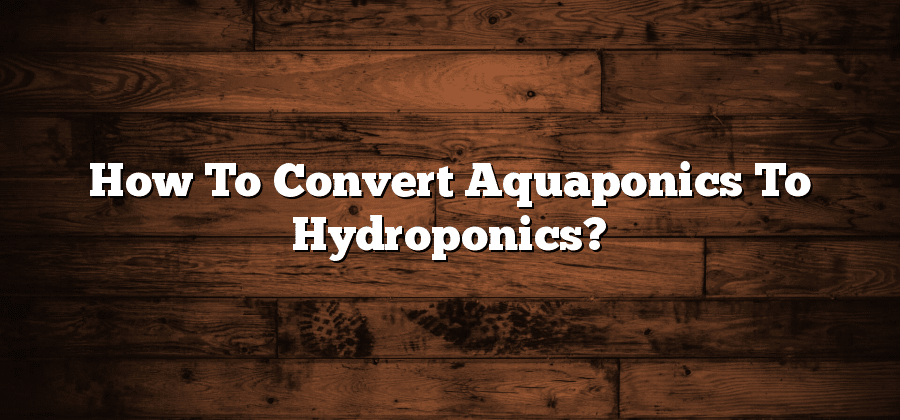Understanding the Key Differences Between Aquaponics and Hydroponics
Aquaponics and hydroponics are two modern methods of cultivating plants without the use of soil. While they may appear similar at first glance, there are key differences between the two systems.
Aquaponics is a sustainable approach that combines hydroponics with aquaculture. In an aquaponics system, plants are grown in water that is enriched with nutrients from fish waste. The plants then filter the water, providing a clean and healthy environment for the fish. This symbiotic relationship creates a closed-loop system where both the plants and the fish benefit each other.
On the other hand, hydroponics is a method of growing plants in a nutrient-rich water solution without the use of soil. The nutrients are supplied directly to the plant roots, allowing for faster growth and increased yields. Unlike aquaponics, hydroponics does not involve fish or any form of aquaculture. Instead, it relies on precise nutrient management and control of environmental factors such as temperature, pH levels, and light.
Understanding these key differences is crucial when deciding which system is best suited for your needs. Both aquaponics and hydroponics have their advantages and disadvantages, and it’s important to consider factors such as space, cost, and time commitment before making a decision.
Evaluating the Benefits of Converting from Aquaponics to Hydroponics
Aquaponics and hydroponics are both innovative methods of farming that allow for exceptional yields in limited space. However, there are distinct benefits to converting from aquaponics to hydroponics. One significant advantage is the ability to have complete control over the nutrient solution. While aquaponics relies on fish waste to provide nutrients to the plants, hydroponics allows growers to tailor the nutrient solution precisely to the specific needs of the plants, resulting in optimal growth and development. This level of control ensures consistency and can lead to higher crop yields.
Another benefit of transitioning to hydroponics is the elimination of the reliance on live fish. In aquaponics systems, fish serve as a vital component of the ecosystem, contributing to the nutrient cycle. However, maintaining a healthy fish population can be challenging, and issues such as disease, poor water quality, or fish mortality can impact the overall success of the system. By converting to hydroponics, growers can remove the fish factor and focus solely on plant growth, reducing the potential risks and complexities associated with managing fish populations.
Assessing the Feasibility of Converting Your Aquaponics System
Converting your aquaponics system to hydroponics can be an enticing prospect, but before diving in, it is crucial to assess the feasibility of such a transition. One of the first factors to consider is the scale of your current aquaponics setup. If you have a small-scale system that caters to your personal needs or a community garden, the transition may be relatively straightforward. However, if you operate a larger commercial aquaponics system, the feasibility becomes more complex, requiring careful planning and analysis.
Another important consideration is the availability of resources. Hydroponic systems often require a more controlled environment and specific equipment, such as grow lights and nutrient solutions. Assessing whether these resources are readily available and affordable for your needs is essential. Additionally, evaluating the availability of space is crucial since hydroponics may require different infrastructure and layout compared to aquaponics. By conducting a comprehensive analysis of your system’s feasibility, you can make informed decisions about moving forward with the conversion process.
Step-by-Step Guide to Transitioning Your Aquaponics Setup to Hydroponics
To successfully transition your aquaponics setup to hydroponics, careful planning and execution are essential. Here is a step-by-step guide to help you navigate the process smoothly.
1. Evaluate Your Aquaponics System: Before making any changes, assess the current state of your aquaponics system. Take into account the size, structure, and functionality of your setup. Identify the components that can be reused or repurposed for hydroponics, such as grow beds, tanks, or pipes.
2. Research Hydroponic Systems: Dive into the vast range of hydroponic systems available and determine which one aligns best with your goals and resources. Consider factors such as the type of plants you want to grow, the space available, and the level of automation desired. Popular options include nutrient film technique (NFT), deep water culture (DWC), and ebb and flow (also known as flood and drain).
By following these initial steps, you will be on your way to successfully transitioning your aquaponics setup to hydroponics. Keep reading to learn more about the subsequent steps and how to choose the right hydroponic system for your needs.
Choosing the Right Hydroponic System for Your Needs
When it comes to choosing the right hydroponic system for your needs, there are several key factors to consider. One of the first things to think about is the type of plants you will be growing. Different plants have different requirements, and certain hydroponic systems may be better suited to support specific types of crops.
Another important factor to consider is the size of your growing space. If you have limited space, you may want to opt for a compact system that can be easily set up in a small area. On the other hand, if you have a larger space available, you may be able to accommodate a larger, more complex system.
Additionally, consider the level of automation and control you desire. Some hydroponic systems offer advanced automation features, allowing you to monitor and control factors such as nutrient levels, pH, and temperature remotely. If you prefer a hands-on approach, you may opt for a more manual system.
Ultimately, the key is to choose a hydroponic system that aligns with your specific needs and goals. By considering factors such as the type of plants you will be growing, the size of your space, and the level of automation desired, you can make an informed decision and select a system that will maximize your success in hydroponic gardening.






